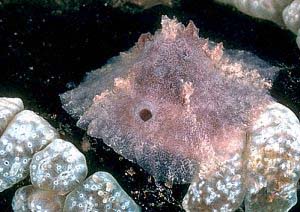
Velutinidae - are they sea slugs?
Order: Sorbeoconcha (Neotaenioglossa)
Family: Velutinidae (Lamellariidae)
PHOTO
Upper: A species of Marseniopsis? with its food, a common compound ascidian. The hole in the front of the animal is the opening of the inhalant siphon leading into the mantle cavity. Arrawarra, Coffs Harbour area, northern New South Wales, Australia. Lower left: Lamellaria australis, Eden, southern New South Wales, February 1983. Lower right: Lamellaria? sp., Solitary Islands, Coffs Harbour Region, northern New South Wales. Photos: Bill Rudman.
RELATED TOPIC
Lamellariids, or as they now should be called, velutinids,(formerly Family Lamellariidae), are caenogastropod snails, closely related to the Triviidae. In most velutinids the shell is open and flattened, much like a small abalone shell (Haliotidae), and at least partially enveloped by the fleshy mantle. This gives them a fleshy shell-less appearance which often causes them to be mistaken for sea slugs. In most cases when they are crawling a pair of head tentacles will emerge from beneath the body, instantly showing that these are not opisthobranch sea slugs. Another character is the anterior siphon above the head which opens into the mantle cavity.
Velutinids all seem to feed on colonial ascidians and many, like the species illustrated, are well camouflaged by their similar colour. Some species however, including some of the large tropical species of Coriocella, are very brightly coloured. This may be a defensive response, as described for many nudibranchs.
Lower left: Lamellaria australis, Eden, southern New South Wales, February 1983. Lower right: Lamellaria? sp., Solitary Islands, Coffs Harbour Region, northern New South Wales. Photos: Bill Rudman.
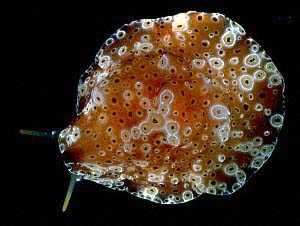
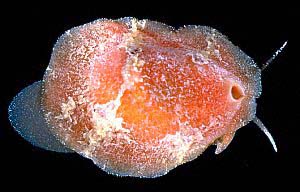
Rudman, W.B., 1998 (October 28) Velutinidae - are they sea slugs?. [In] Sea Slug Forum. Australian Museum, Sydney. Available from http://www.seaslugforum.net/find/lamellar
Related messages
Colpodaspis sp ??
April 19, 2010
From: Jean Michel Crouzet
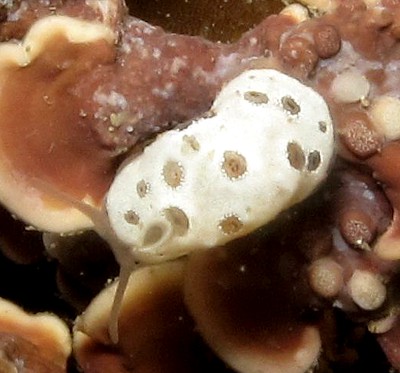
Hello,
During a dive in Ile de groix, Bretagne, France yesterday, a friend found this cephalaspidae (i think) 3/4 mm in 2 meter deep. It looks looks like Colpodapsis pusilla but it has more holes.
Can you help me for identification (Sorry for my English)
Locality: ile de groix, 2 metres, Bretagne [Brittany] France, Atlantic Ocean, 09 April 2010. Length: 3/4 mm. Photographer: Christophe Moreau.
Jean Michel Crouzet
jean_michel.crouzet56@orange.fr
Crouzet, J.M. , 2010 (Apr 19) Colpodaspis sp ??. [Message in] Sea Slug Forum. Australian Museum, Sydney. Available from http://www.seaslugforum.net/find/23507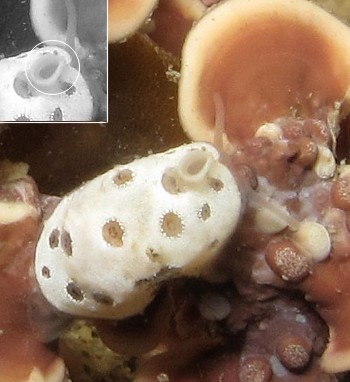
Dear jean michel,
The general shape is similar to Colpodaspis, but the raised hole in your animal, which is a short tubular siphon, is at the front of the animal, over its head, while in Colpodaspis the siphon is on the right side near the back of the body. The position of the siphon, which takes water into the 'mantle cavity' and over the gills, represents one of the main differences between sea snails and sea slugs [see Fact Sheet on torsion and detorsion].
Your animal is a sea snail in which the shell is covered by a layer of skin. It is belongs to the family Velutinidae [Lamellariidae] and is most probably a species of Lamellaria. Many species are quite variable in colour and unfortunately the best way to indentify them is to take out their shell. sometimes.
The brownish spots all over your animal look like holes but are in fact not. Velutinids feed on colonial ascidians, and these hole-like spots look like the water siphons of the colonial ascidians they eat [see photos on ascidian Fact Sheet]. It is all part of their elaborate camouflage
Best wishes,
Bill Rudman
Lamellaria from Tunisia
January 18, 2010
From: Jamila Ben Souissi
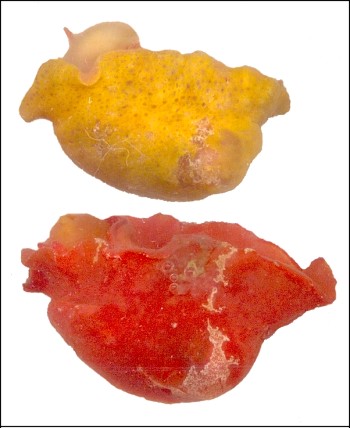
Dear Bill
Glad to contact you again. Recent investigations conducted along the Tunisian coasts allowed us to collect the following Seaslugs. Can you please confirm the identification?
Locality: Gulf of Hammamet, 65-67m depth, 18 April 2009, Photographer: Jamila Ben Souissi
Best wishes
Jamila Ben Souissi
bensouissi.jamila@inat.agrinet.tn
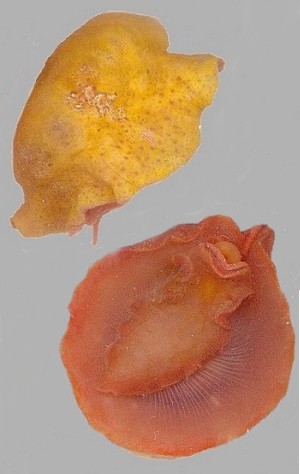
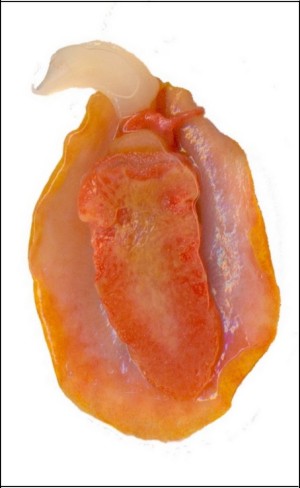
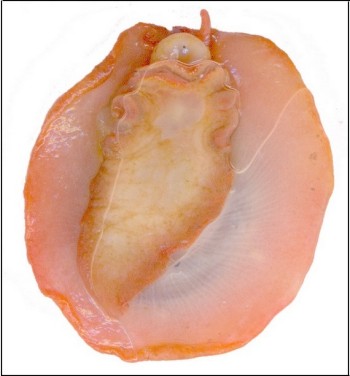
Dear Jamila,
This is one of the many sea snails which look like slugs - mainly because they have covered their shells with a flap of mantle skin. These are velutinid snails most probably of the genus Lamellaria. If you look at earlier messages concerning velutinids from the Mediterranean, it is probable that you have more than one species, but without a look at the internal anatomy and the internal shell it is not easy to identify these species.
Some of your ventral photos show the head and head tentacles which are typical of snails, and in the middle right photo, the large white organ is most probably the penis extending out of the mantle cavity, which opens above the head
Best wishes,
Bill Rudman
Unknown seaslug from Whangaparaoa, New Zealand
August 20, 2009
From: Graham Bould
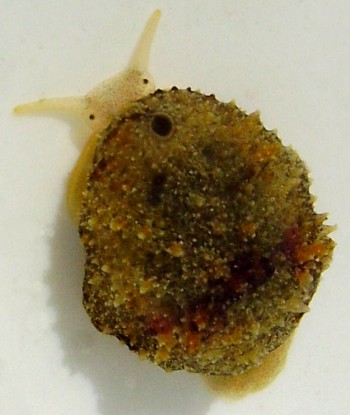
Dear Bill,
Two photos attached, one showing the underside. I have been unable to ID this & hope that you can help with a name. This is the only one I have ever seen, so it would appear to be uncommon. It can move rapidly. The skin seems similar to an octopus.
Locality: Rocks, Low tide level, Whangaparaoa, New Zealand, Pacific, 22 July 2009, Under stone in rock pool. Length: 25 mm. Photographer: Graham Bould.
Graham Bould
graham@grahambould.net
Bould, G., 2009 (Aug 20) Unknown seaslug from Whangaparaoa, New Zealand. [Message in] Sea Slug Forum. Australian Museum, Sydney. Available from http://www.seaslugforum.net/find/22591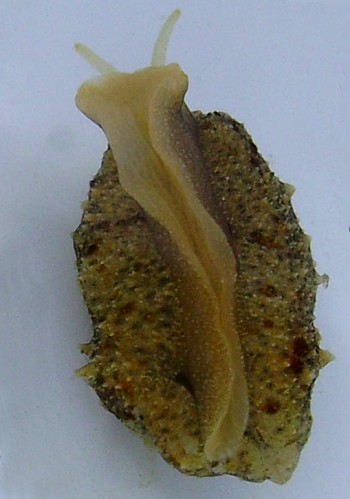
Dear Graham,
Although it has no external shell, this is a snail rather than a sea slug. In fact it has quite a large shell which is enclosed within the mantle skin. It is a member of the family Velutinidae [Lamellariidae]. Have a look at the family Fact Sheet and some of the messages attached to that Fact Sheet for more information on these animals. I used to know the names of the New Zealand lamellariids but they have changed considerably in the last 40 years so I won't hazard a guess.
Best wishes,
Bill Rudman
Shell-less gastropod from Gulf of St Lawrence, Canada
July 21, 2007
From: Patrice Goudreau
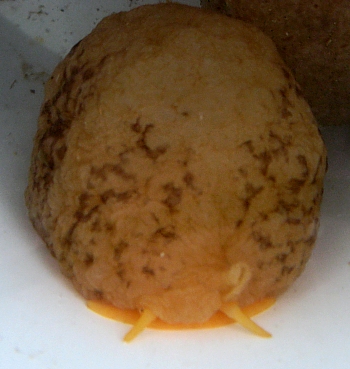
Hello,
These are photos of a specimen of soft-shell gastropod that was fished in a scallop dredge during a scientific survey. The survey was conducted in the Mingan Archipelago in the Gulf of St Lawrence in eastern Canada. If someone could give some information about this specimen I would appreciate it. The substrate was composed of sand, shell and gravel and the water temperature was about 2 degrees Celcius. There was scallops (Chlamys islandica), seastars, urchins, Gersemia rubiformis (soft coral) fixed in shells and a few other species. The specimen was put back in the water
Locality: Havre-St-Pierre, 45 metres, Quebec, Canada, Gulf of St-Lawrence, June 6th 2007, Sand and shell with about 20% of gravel. Length: about 150 mm. Photographer: Patrice Goudreau.
Thank you for your attention
Patrice Goudreau
Aquatic science technician
Fisheries and Oceans Canada
Maurice Lamontagne Institute
Mont-Joli, Quebec, Canada
GoudreauP@dfo-mpo.gc.ca
Goudreau, P., 2007 (Jul 21) Shell-less gastropod from Gulf of St Lawrence, Canada. [Message in] Sea Slug Forum. Australian Museum, Sydney. Available from http://www.seaslugforum.net/find/20216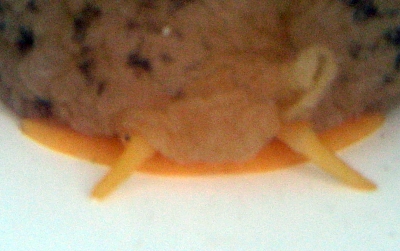
Dear Patrice,
This is a gastropod snail rather than a gastropod sea slug, and belongs to the family Velutinidae (which now includes the well known family Lamellariidae). They do have a shell, but it is usually hidden beneath the skin of the mantle. In the close-up alongside you can see the eye at the base of the head tentacles which is a coenogastropod character, and the funnel-like siphon which draws water back over the gills which are hidden in the shell-covered mantle cavity situated behind the head.
I can't give you a species name but it's possibly a species of Lamellaria. A good shell book covering your region should help. Unfortunately one problem with identifying velutinids is that the books often have drawings and descriptions only of the shells which is a problem if you only have pictures of the animal.
Best wishes,
Bill Rudman
Re: Photo of a living 'Berthella' sideralis
January 15, 2007
From: Jussi Evertsen
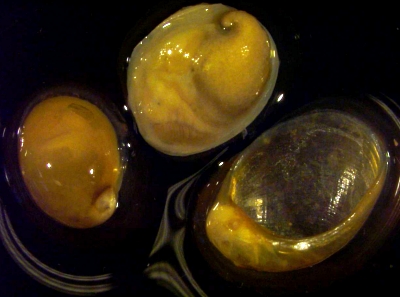
Concerning message #19147:
Hi Bill,
I have gone back to the preserved material, and taken a closer look at the animals by removing the shell from one. What we have here is a shell that is coevered by a periostracum, even over the protoconch. The shell is thin and fragile and even flexible, and you can clearly see the internal structures through it. I guess this thin and transparent periostracum could make the animal look like it has a dorsal mantle.
Locality: Rundholmen, 28 m, Bud, Norway, 21 May 2004, hard bottom. Length: 20 mm. (material is the same as the photos of the living specimens, from Rundholmen). Photographer: Anita Kaltenborn.
Attached is a photo of two specimens, one to the lower left with the shell attached, the top animal without shell where the shell is to the right.
This animal fits very well with Velutina plicatilis (Muller, 1776) as described in Fretter & Graham (1981). A small step for human kind, but a great step for us, and now we have tidied up this animal.
Jussi
jussi.evertsen@bio.ntnu.no
Evertsen, J., 2007 (Jan 15) Re: Photo of a living 'Berthella' sideralis. [Message in] Sea Slug Forum. Australian Museum, Sydney. Available from http://www.seaslugforum.net/find/19220Dear Jussi,
Thanks for the follow-up. Although it's not Berthella sideralis, it is nice to have solved the problem of its identity.
Best wishes,
Bill Rudman
Re: Photo of a living 'Berthella' sideralis
January 8, 2007
From: Jussi Evertsen
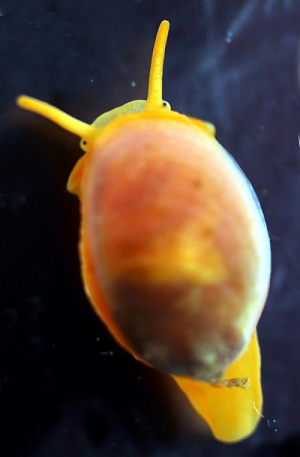
Concerning message #19133:
Hi Bill,
I did identify Erling's specimen [message #19089] as a Berthella based on material that I have myself of similar looking specimens, but with tissue covering the whole dorsum. I suspected Erling's specimen to be damaged. My ID is based on the descriptions given in Odhner (1939). In my notes in my field notebook I noted the internal shell visible thorugh the dorsal tissue, and the gills located in a cavity on the sides between the dorsal tissue and the foot.
Here are the photos of the specimen of Berthella that I have from Rundholmen at Bud 20/5 2004, collected at 28 meters depth. The specimen is 20 mm from the head to the end of the tail.
Also I have scanned the illustrations given in Odhner (1939) with lateral illustrations of B. plumula and B. sideralis. I also scanned the shell of B. plumula. In Odhner (1939) it is mentioned that B. plumula has been collected from the the tidal zone. I do not agree that Erling's specimen is a velutinid, but a damaged Berthella exposing the internal shell, because his specimen is similar to the above given specimens ID'd as Berthella from Odhners descriptions and illustrations.
Locality: Rundholmen, 28 m, Bud, Norwegian west coast, 20 May 2004, rocky bottom, steep slope. Length: 20 mm. Photographer: Petter Schmedling.
-
Odhner, N.H. (1939) Opisthobranchiate Mollusca from the western and northern coasts of Norway. Det Kongelige Norske Videnskabernes Selskabs Skrifter, 1: 1-93.
Jussi
jussi.evertsen@bio.ntnu.no
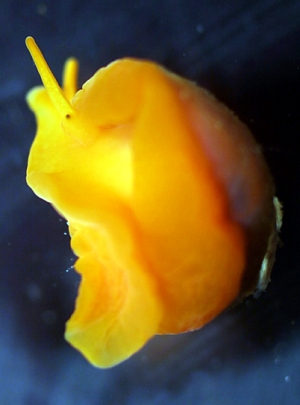
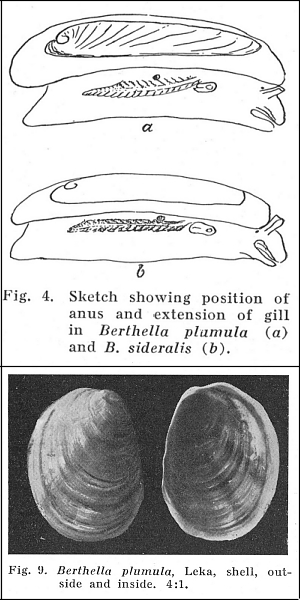
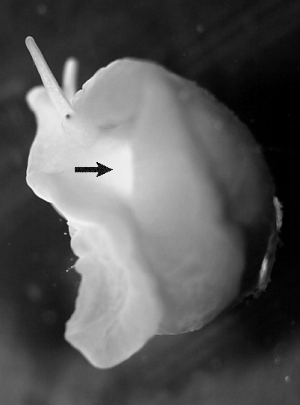
Dear Jussi,
Thanks for these photos. If I had had these with Erling's message I would not have considered to be a pleurobranch. It is clearly a velutinid. In Erling's photo the head tentacles are short and blunt and I was happy to interpret the eye spots as being in the body wall at the base of the tentacles as you might expect in a pleurobranch. Your photos clearly show the long tapering head tentacles and the eyes in little pockets on the base of the tentacle - both characters of what we used to call 'prosobranch' gastropods, but not found in opisthobranchs. More specifically in pleurobranchs, we would expect to find enrolled tentacles, as illustrated in Odhner's sketches, and can be seen in many photos on the Forum of species of Berthella.
Why I asked Erling if he had a photo of the right side of the animal was to see if I could see any sign of the gill which, as illustrated in Odhner's sketches, should be on the right side of the body under the mantle. Your second photo shows the underside of the body from the left side, so we wouldn't see the gill if it was a pleurobranch. However it is very valuable because it shows a clear channel - above the head - leading down to a large hole [arrowed] behind the left eye. This hole is the inhalent opening into the mantle cavity, through which water enters the mantle cavity which contains the chemosensory osphradium, the gills, anus, kidney and reproductive openings. In velutinids the mantle cavity is situated above the head and anterior body and covered by the shell. In pleurobranchs, this mantle cavity is lost, all that remains of it is the region on the right side of the body where we find the gill, anus and reproductive openings.
You mention differences in shell exposure. In some velutinids the amount of shell visible is very variable because the mantle covering it is quite contractile, much like in many cowry snails. Unfortunately it seems we are yet to see a living Berthella sideralis. It puzzles me that all the preserved specimens of B. sideralis and its Nth American counterpart Gymnotoplax americanus (Verrill, 1885) have the shell greatly exposed, much as in Erling's photo. I have never seen that happen in preserved specimens of other species of Berthella, so perhaps Berthella sideralis does have an exposed shell when alive. The other alternative, that all specimens so far collected have suffered identical damage seems rather unlikely.
Best wishes,
Bill Rudman
Re: Photo of a living 'Berthella' sideralis
January 5, 2007
From: Jeff Goddard
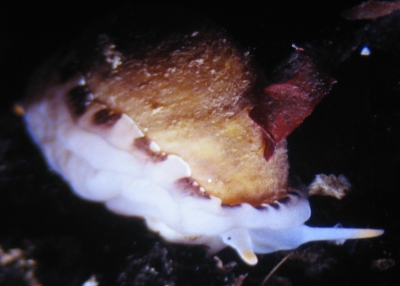
Concerning message #19089:
Bill,
Based on the position of the cephalic tentacles, and especially the eyespots, I think that the animal pictured in Erling Svensen's photo is a Velutina, which is of course a prosobranch. Although the color pattern is different, the partially exposed shell and overall shape of the body are very similar to Velutina prolongata, known from the north Pacific.
Here is an aquarium image of Velutina prolongata showing an eyespot at the base of one of the cephalic tentacles. For a good image of an extended, crawling individual (to compare to the animal in Erling Svensen's image) see Clinton Bauder's image in message #7688.
Locality: unknown locality, unknown, Oregon, USA, Northeast Pacific, January 1996, Rocky subtidal. Length: Approximately 20 mm. Photographer: David Pitkin, US Fish & Wildlife Service.
Best wishes,
Jeff
goddard@lifesci.ucsb.edu
Goddard, J.H.R., 2007 (Jan 5) Re: Photo of a living 'Berthella' sideralis. [Message in] Sea Slug Forum. Australian Museum, Sydney. Available from http://www.seaslugforum.net/find/19133Dear Jeff,
The great find for the new year may quickly become my great mistake for 2007. I wondered about a velutinid but on checking with Erling he said the identification was based on advice from local experts. Of course I take full responsibility. I would appreciate other comments. If it is a velutinid I think I should remove the message and start again
Best wishes,
Bill Rudman
Photo of a living 'Berthella' sideralis
January 5, 2007
From: Erling Svensen
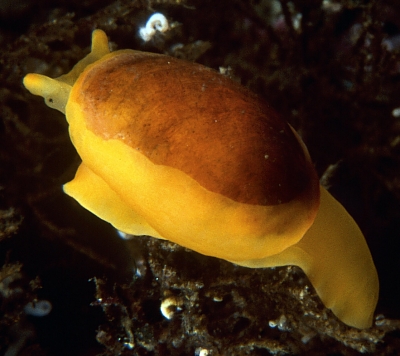
I have a picture of Berthella sideralis from Stavanger in Norway (South West of Norway). I see that you miss this species from your list.
Locality: Stavangere, 15 meter, Norway, Norwegian Sea, November 2002, Rocky wall falling down to 50 meter. Length: 2 cm. Photographer: Erling Svensen.
Best regards
Erling Svensen
www.marinbi.com
erling@egersund.com
Svensen, E., 2007 (Jan 5) Photo of a living 'Berthella' sideralis. [Message in] Sea Slug Forum. Australian Museum, Sydney. Available from http://www.seaslugforum.net/find/19089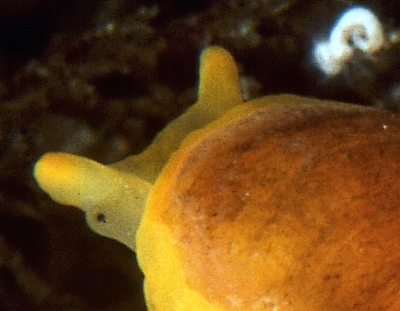
Note: see messages #19133 and #19147 showing this is a velutinid.
Dear Erling,
Thanks for this valuable contribution. Even though we are only a few days into the new year I can confidently say that this is one of the most important messages of 2007. This is the first time I have seen this species alive, and I know of no published account of it alive.
Your photo clearly shows that the shell is exposed, not because the animal has been damaged, but because it retains a primitive character lost in all other pleurobranchs. Your photo also shows that the head is quite different from that found in species of Berthella. In your animal the rhinophores are short extensions to the outer corners of the oral veil, and the eyes, at the base of the rhinophores, are much further forward than found in other pleurobranchs. In Berthella, the oral veil and rhinophores are separate, and the eyes, at the base of the rhinophores are hidden beneath the anterior edge of the mantle.
Berthella sideralis was previously known from a very few records from deep water [200 -1100 m] off the Atlantic coast of Europe, so your find from 15 m suggests an extremely wide depth range for this species. Although not quite as extreme, I have reported Umbraculum umbraculum from the intertidal to 270 m deep off eastern Australia [message #724]. What makes your photo particularly interesting is that on the Atlantic coast of Nth America, another very similar-looking deep water pleurobranch has been reported, Pleurobranchus americanus, which was placed in a distinct genus Gymnotoplax [= naked shell] based primarily on the external shell. It is most probable (see Bouchet, 1977) that these two species are the same. However researchers have only had preserved specimens to study, and since Willan (1978) concluded that the 'hole' in the mantle had been produced by mantle damage during collection, all have agreed with his decision that Gymnotoplax is an unnecessary genus. Your photo shows that the external shell is a 'real' character, and that Gymnotoplax represents a distinct group of pleurobranchs with an external shell and combined oral veil and rhinophores.
Your message reminds me of one some years ago from Atsushi Ono [message #6231] which included a photo which I identified as Sohgenia palauensis. Previously this species had never been seen intact, so the photo enabled us to correctly understand its phylogenetic relationships for the first time. If you have other photos of Berthella sideralis which perhaps show the head from another angle, or the right side of the animal, I would love to see them.
Best wishes,
Bill Rudman
Re: Lamellaria from Turkey
December 15, 2006
From: Mehmet Baki Yokes
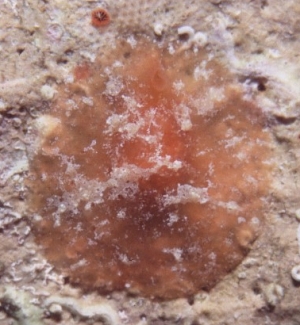
Concerning message #18955:
Dear Bill and Haluk,
Last summer we had a biodiversity expedition in Gokova Bay, very near to Bodrum (Turkey). I collected many Lamellaria specimens, all had different colurs, and some had even different mantle texture, but when I checked the inner shells, all turned out to be Lamellaria latens. So the specimen in Ferda's photo may also be L. latens.
Locality: Gokova, 2-5m, Turkey, Mediterranean, July 2006, rocky. Length: 2-3 cm. Photographer: M. Baki Yokes.
Best wishes
Baki
bakiyokes@turk.net
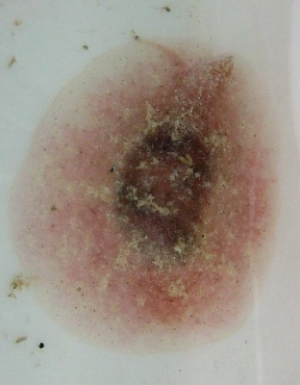
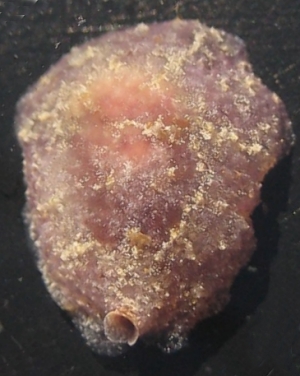
Thanks Baki,
You could be quite right. I identified it as Lamellaria perspicua because Lucas Cervera had identified a very similar looking photo [message #15596] as that species. These slug-like snails cause the same identification problems as true sea slugs do - in many cases identifications from photos can only be tentative until you have a look inside.
Best wishes,
Bill Rudman
Lamellaria from Turkey
December 13, 2006
From: Haluk Akbatur
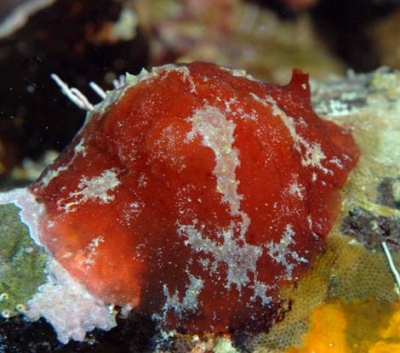
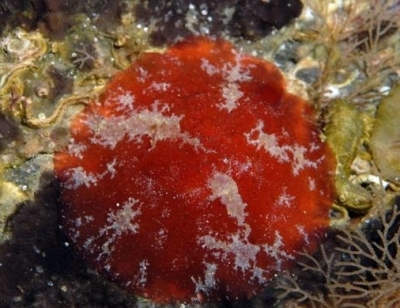
Dear Bill,
Here are two photograph of an opistobranch which were taken by Ferda Büyükbaykal from Bodrum, on the southwest coast of Turkey last month. I think it is s pleurobranch.
Locality: Bodrum, 25 m, SW Turkey, Mediterranean, 25 October 2006, rocky bottom. Length: 4 cm. Photographer: Ferda Büyükbaykal.
I would like assistance in identifying it please
Haluk Akbatur
lasergoz@ttnet.net.tr
Akbatur, H. H., 2006 (Dec 13) Lamellaria from Turkey. [Message in] Sea Slug Forum. Australian Museum, Sydney. Available from http://www.seaslugforum.net/find/18955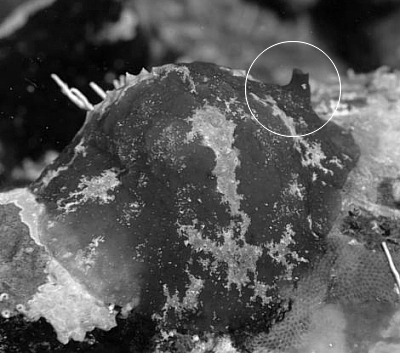
Dear Haluk,
Certainly the anterior siphon [ringed] can be mistaken for the posterior siphon of some pleurobranchs, but if you had turned this animal over you would have seen a recognisable 'snail' head. This is the velutinid snail, Lamellaria perspicua. Have a look at the Fact Sheet for the velutinids and the attached messages. This group of snails have a reduced flattened internal shell, and their bodies are often brightly coloured or strangely shaped, much like opisthobranchs.
Best wishes,
Bill Rudman
Unknown dorid? from the Red Sea
June 16, 2006
From: Neil Horlock
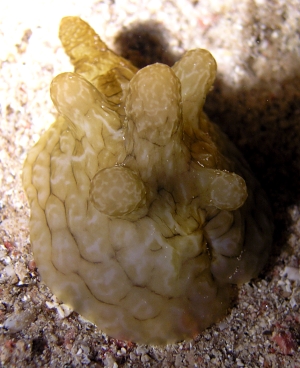
This Dorid was spotted at the end of a night dive in Dahab, Sinai, Egypt, on May 24th 2006.
It was moving along the course sandy bottom at the base of the reef. In colour and shap it looks most similar to the Clumpy Dorid (Asteronotus cespitosus ) but there were no gills visible so I have my doubts.
Locality: Dahab, 5-7m, Sinai, Egypt, Red Sea, 24 May 2006, sandy bottom. Length: 100 mm (4 inches). Photographer: Neil Horlock.
Neil Horlock
neil_seaslug@zyxt.org
Horlock, N.G., 2006 (Jun 16) Unknown dorid? from the Red Sea. [Message in] Sea Slug Forum. Australian Museum, Sydney. Available from http://www.seaslugforum.net/find/16816Dear Neil,
You were right to be a bit suspicious of the identity of this animal. Although it looks like a sea slug, it is in fact a velutinid snail with an enclosed shell. It is most probably a species of Coriocella or Chelynotus. If you look at the Fact Sheet and the earlier messages you will find some background information on these slug-like snails.
Best wishes,
Bill Rudman
Velutinid snail from Japan
April 6, 2006
From: Yasuhiro Shamoto
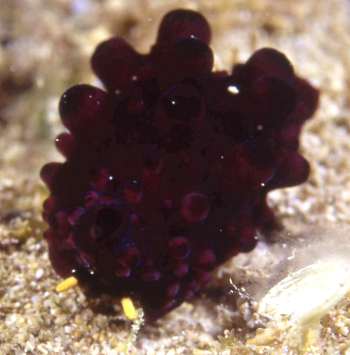
Dear Dr.Rudman
Hello.I write to you for the first time. My name is Yasuhiro Shamoto from Aichi Prefecture. Japan. I send photograph of sea slug what do you think?
I'm sorry my English is very poor.
Locality: Tebiro Beach, Amami-Ooshima Island, 1.5 metres, Japan, Pacific Ocean, 23 March 2006, sandy place. Length: 30 mm. Photographer: Yasuhiro Shamoto
Yours sincerely
Yasuhiro Shamoto
yasunao515@cyber.ocn.ne.jp
Yasuhiro Shamoto, 2006 (Apr 6) Velutinid snail from Japan. [Message in] Sea Slug Forum. Australian Museum, Sydney. Available from http://www.seaslugforum.net/find/16220Dear Yasu,
Although this looks like a slug it is in fact a snail, but it has its shell hidden in its skin. It belongs to a family of snails called the Velutinidae. I think yours is probably Coriocella nigra but I am afraid the names are a bit confused in that family at the moment. It needs some serious research. Have a look at message #3521 for some other photos. In your photo you will see the pair of yellow head tentacles which are a clue that this is a 'snail' not a 'slug'.
Best wishes,
Bill Rudman
Berthella? from Croatia
February 28, 2006
From: Mat Vestjens
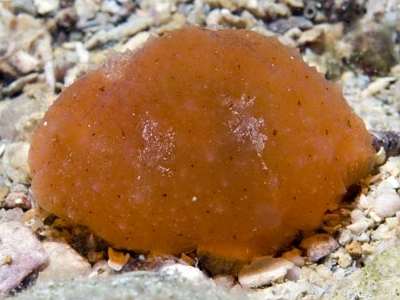
Hello Bill,
The two attached pictures are made last weekend in Selce, Croatia. We found Berthella aurantiaca during previous dives, but the specimen on the picture is different. It is not smooth and it has small spots. The size was also bigger than that of B. aurantiaca, it was about 30 mm long. The picture was taken at a depth of appr. 6 metres during a night dive. The animal was found on the sand, as the pictures show.
Locality: Selce, 6 metres, Croatia, Adriatic, 11 February 2006, Sandfloor. Length: 30 mm. Photographer: Mat Vestjens.
Can you tell us what species it is?
Best regards,
Mat Vestjens & Anne Frijsinger
annenmat@natuurlijkmooi.net
Vestgens, M., 2006 (Feb 28) Berthella? from Croatia. [Message in] Sea Slug Forum. Australian Museum, Sydney. Available from http://www.seaslugforum.net/find/15868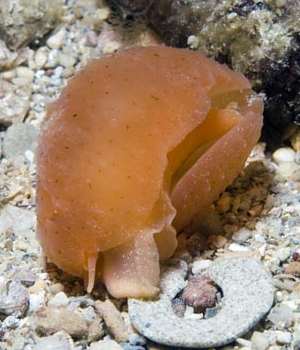
Dear Mat,
I am pretty sure this is a velutinid, perhaps a species of Lamellaria, rather than an opisthobranch. The head tentacles, which poke out from under the mantle seem solid. In a pleurobranch they would be a hollow rolled tube.
Best wishes,
Bill Rudman
Re: Nudibranch ? from Spain
January 20, 2006
From: Juan Lucas Cervera
Concerning message #15596:
Dear Bill and Marga,
This animal is Lamellaria perspicua.
Regards.
Lucas.
lucas.cervera@uca.es
Cervera, J.L., 2006 (Jan 20) Re: Nudibranch ? from Spain. [Message in] Sea Slug Forum. Australian Museum, Sydney. Available from http://www.seaslugforum.net/find/15620Thanks Lucas,
Bill Rudman
Nudibranch ? from Spain
January 19, 2006
From: Marga Iglesias
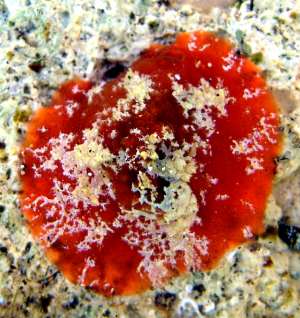
Dear Dr. Rudman,
I am writing to you because I am a nudibranch lover after diving for many years. I am a passionate reader of your marine guides but, unfortunately I haven´t been able to identify a particular specimen that I found last October. I would be really pleased if you could tell me which one this is.
Locality: Cabo de Gata (Almeria), SPAIN. Mediterranean coast: Depth: 1 metre. Length: 30-40 mm. 11 October 2005. Intertidal. Photographer: Marga Iglesias
Thank you very much in advance and all my compliments to you and your forum colleagues. It has been a real joy to know of you through Internet.
Happy new year to you all from Spain!!
Yours sincerely
Marga Iglesias
miglesias@aragon.es
Iglesias, marga, 2006 (Jan 19) Nudibranch ? from Spain. [Message in] Sea Slug Forum. Australian Museum, Sydney. Available from http://www.seaslugforum.net/find/15596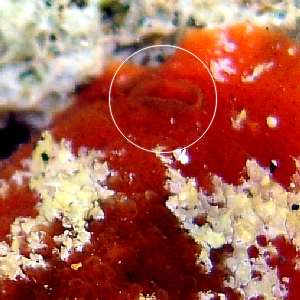
Dear Marga,
It certainly looks colourful enough to be a nudibranch, but I am pretty sure this is a snail which has covered its shell with a layer of skin, and so looks like a slug. I could be wrong but I think this is a velutinid. They certainly look like snails if you turn them over and look at their head and foot, but one way you can identify them from above is the single siphon [or funnel] at the front of the body which carries water down to the gill. I have ringed what I think is the siphon in the close-up alongside. It is possibly a species of Lamellaria
Best wishes,
Bill Rudman
Re: Mysterious sea slug? from Cornwall
November 15, 2005
From: Bernard Picton
Hi Bill,
Concerning Judith's message [#15139] I think this is Lamellaria latens, as you say a Velutinid prosobranch (snail). In Plymouth there should be two species of Lamellaria, L. latens and L. perspicua, I think the small one with black spots is L. latens but external coloration is very variable.
Bernard
bernard.picton@magni.org.uk
Picton, B.E., 2005 (Nov 15) Re: Mysterious sea slug? from Cornwall. [Message in] Sea Slug Forum. Australian Museum, Sydney. Available from http://www.seaslugforum.net/find/15272Thanks Bernard,
It's nice to have mysteries cleared up
Best wishes,
Bill Rudman
Mysterious sea slug? from Cornwall
November 1, 2005
From: Judith Oakley
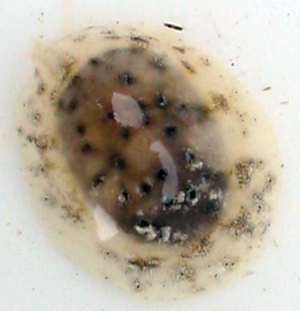
Bill,
I came across this species on a marina pontoon. Have looked in all books I have available and can find nothing resembling it. The photo is not very good quality but hopefully you may have some ideas. It was very small - 6 mm and black/white in colour with a very oval shape. Also attaching underside photo.
Locality: Falmouth, Cornwall, UK. Length: 6 mm. 26 October 2005. marina pontoon. Photographer: Judith Oakley
best wishes
Judith
jomoakley@btinternet.com
Oakey, J.A., 2005 (Nov 1) Mysterious sea slug? from Cornwall. [Message in] Sea Slug Forum. Australian Museum, Sydney. Available from http://www.seaslugforum.net/find/15139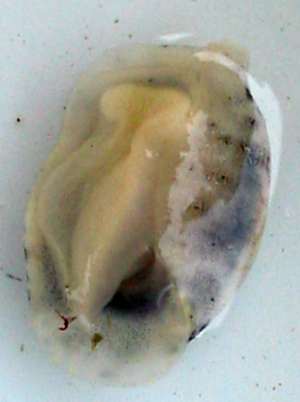
Dear Judith,
The underside photo is useful. Although we can't see head tentacles I am sure this is a 'snail' rather than a 'slug'. You can see a hint of an anterior siphon at the front of the body, and also the dark shadow in the upper photo is almost certainly the shell. There are two white patches which I think ia the white shell. What I can't be sure of is whether the white patches are visible because of damage to the overlying mantle or not. There are two possibilities. It is either a species of the cowry-like Trivia, which in juveniles have a smooth shell like this, and a large mantle flap on each side which can cover the shell. If the gaps I can see in your photo are 'natural' then this is most probably a juvenile Trivia. If the gaps are caused by damage, then this is most probably a juvenile velutinid, probably a species of Lamellaria. Sorry I can't be more specific but at least it will suggest some names to look up. Both feed on ascidians.
Best wishes,
Bill Rudman
Re: Unidentified Arctic 'Nudibranch'
September 15, 2005
From: Philip Sargent
Tim:
Concerning your message #14177:
I found your photo extremely interesting. I myself have observed a Velutinid here in Newfoundland, though the one I observed looks considerably different than the one you have pictured here. I've been trying to identify mine for the last year and it hasn't been easy. I believe mine is of the genus Onchidiopsis and may be O. corys. I've been in touch with researchers around the globe and it appears this group is difficult to accurately identify but morphology of it's internal shell definitely helps narrow it down. I see there was a reply [#14190] to your message with a couple of references that may help you, but the list is incomplete. Here's a complete list of references for northern velutinids. If you take out the internal shell and look at these references they have fairly decent pictures for comparison.
-
Gulbin, V. V. and A. N. Golikov. 1997. A review of the prosobranch family Velutinidae in cold and temperate water of the northern hemisphere. I. Capulacmaeinae. Ophelia 47: 43-54.
-
Gulbin, V. V. and A. N. Golikov. 1998. A review of the prosobranch family Velutinidae in cold and temperate water of the northern hemisphere. II. Velutininae: Genus Limneria. Ophelia 49: 211-220.
-
Gulbin, V. V. and A. N. Golikov. 1999. A review of the prosobranch family Velutinidae in cold and temperate water of the northern hemisphere. III. Velutininae. Genera Ciliatovelutina and Velutina. Ophelia 51: 223-238.
-
Gulbin, V. V. and A. N. Golikov. 2000. A review of the prosobranch family Velutinidae in cold and temperate water of the northern hemisphere. IV. Velutiniae. Genera Velutella, Cartilagovelutina and Marsenina. Ophelia 53: 141-149.
-
Gulbin, V. V. and A. N. Golikov. 2001. A review of the prosobranch family Velutinidae in cold and temperate water of the northern hemisphere. V. Onchidiopsinae. Ophelia 54: 119-132.
Is this the only specimen you've observed or have you seen them regularly? The one I observed is the only one I have ever seen. Apparently they are quite rare but occasionally can be found in large numbers. I believe this may be when they are breeding. If you come across anymore of these animals I'd love to have some to examine for myself. If you find more and are willing to send some to me, e-mail me and we'll figure out how to do this.
Cheers,
Philip
philips@mun.ca
Sargent, P. S., 2005 (Sep 15) Re: Unidentified Arctic 'Nudibranch'. [Message in] Sea Slug Forum. Australian Museum, Sydney. Available from http://www.seaslugforum.net/find/14772Dear Philip,
Thanks for the information. Since velutinids only end up on the Sea Slug Forum by accident, perhaps you should get in touch with Tim by using the email address on his message. As much as I would like to increase the scope of the Forum, it would be a logistic impossibility.
Best wishes,
Bill Rudman
Re: Velutinidae in the Arctic
July 5, 2005
From: Constantine Mifsud
Concerning the Arctic velutinid messag [#14177]:
The species of the Northern Velutinidae have been revised by Gulbin & Golikov in Ophelia nos. 49 & 51.
-
Gulbin & Golikov: 1998 A review of the Prosobranch Family Velutinidae in cold and temperate waters of the Northern Hemisphere.Ophelia 49 (3): 211-220. Moscow.
-
Gulbin & Golikov: 1999 A review of the Prosobranch Family Velutinidae in cold and temperate waters of the Northern Hemisphere Ophelia, 51 (3): 223-238.
regards,
Constantine
kejdon@orbit.net.mt
Mifsud C., 2005 (Jul 5) Re: Velutinidae in the Arctic. [Message in] Sea Slug Forum. Australian Museum, Sydney. Available from http://www.seaslugforum.net/find/14190Thanks Con,
Bill Rudman
Unidentified Arctic 'Nudibranch'
July 1, 2005
From: Tim Siferd
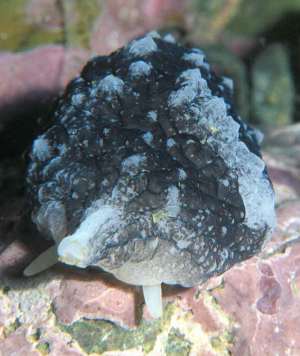
Is there anyone out there that might be familiar with this creature photographed in the Canadian Arctic near Resolute?
Locality: Resolute, NU 74°44'N 95°37'W. Canada, Arctic Ocean. Depth: 10-20 m. Length: approx. 4 cm. 24 August 1991. Boulder. Photographer: Tim Siferd
Tim Siferd
siferdtd@dfo-mpo.gc.ca
Siferd, TD, 2005 (Jul 1) Unidentified Arctic 'Nudibranch'. [Message in] Sea Slug Forum. Australian Museum, Sydney. Available from http://www.seaslugforum.net/find/14177Dear Tim,
This is a slug-like snail of the Family Velutinidae. If you look at the Fact Sheet and associated messages, you will get an idea of the diversity of these animals. Hopefully someone will be able to help you with an identification, specially since the animal is from such a location which I presume doesn't support a very diverse velutinid fauna. Unfortunately most of the taxonomy of this group is based on the shape of the internal shell, which isn't much use when you are trying to identify live animals, or photos of live animals.
Best wishes,
Bill Rudman
Re: Corambe? or velutinid from California
May 19, 2005
From: Jeff Goddard
Hi Bill,
The dorid-like animal in Carmelita Hansen's photo [#13774] is a Velutinid [or marseniid or lamellariid depending on the state of the ongoing discussion on the relationships of these animals]. I think I can see a dorsal mantle slit in the photo which would make this a species of Marsenina, probably M. rhombica. It preys on compound ascidians, on which they are very cryptic (a compound ascidian appears to be present in the lower left of Carmelita's photo). Not visible in the photo are the thin head tentacles with eyespots at their bases. I have also sent photos of a couple of other Californian species [messages #13810, #13816].
Best wishes,
Jeff
goddard@lifesci.ucsb.edu
Goddard, J.H.R., 2005 (May 19) Re: Corambe? or velutinid from California. [Message in] Sea Slug Forum. Australian Museum, Sydney. Available from http://www.seaslugforum.net/find/13808Thanks Jeff,
Best wishes,
Bill Rudman
Marsenina stearnsii from Oregon
May 19, 2005
From: Jeff Goddard
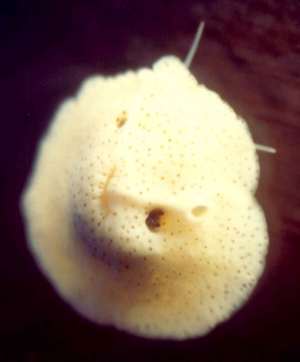
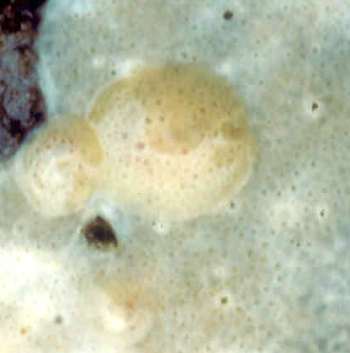
Hi Bill,
To accompany my previous message [#13808] on the Marsenina in Douglas Hansen's message, here are two photographs of Marsenina stearnsii, one showing four individuals on a didemnid ascidian in the field. As you can see, these snails blend in pretty well on their prey and can also easily be mistaken for dorid nudibranchs. However, when relaxed and crawling, their head tentacles and lack of both rhinophores and branchial plumes become apparent. The upper photo shows the dorsal slit in the mantle, characteristic of this genus.
Locality: Cape Arago, Oregon, USA. Pacific Ocean. Intertidal. Upper image: Length: 22 mm, June 1980. Lower image: May 1986. Intertidal, under a cobble. Photographer: Jeff Goddard
Best wishes,
Jeff
goddard@lifesci.ucsb.edu
Goddard, J.H.R., 2005 (May 19) Marsenina stearnsii from Oregon. [Message in] Sea Slug Forum. Australian Museum, Sydney. Available from http://www.seaslugforum.net/find/13810Thanks Jeff,
No matter how hard I try to avoid these slug-like snails, I must admit that the velutinids show fascinating parallels to nudibranchs. This photo clearly shows the dorsal slit in the mantle. I often need to check for the slender head tentacles to confirm they are not opisthobranchs.
Best wishes,
Bill Rudman
Lamellaria diegoensis from Oregon, USA
May 19, 2005
From: Jeff Goddard
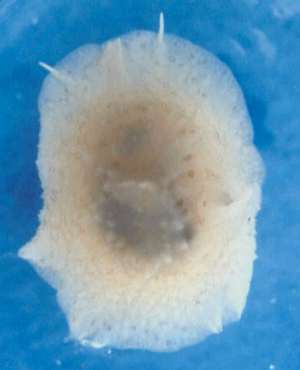
Hi Bill,
As promised earlier [message #13808] here is a photo of Lamellaria diegoensis, another marseniid that might be mistaken for a dorid nudibranch. This specimen was found on a thick, Aplidium-like compound ascidian. Species of Lamellaria lack a dorsal slit in the mantle, and as illustrated in this photo, L. diegoensis usually has dorsal tubercles.
Locality: Cape Arago, Oregon, USA. Pacific Ocean. Intertidal. Length: 31 mm. August 1981. Intertidal cave. Photographer: Jeff Goddard
Best wishes,
Jeff
goddard@lifesci.ucsb.edu
Goddard, J.H.R., 2005 (May 19) Lamellaria diegoensis from Oregon, USA. [Message in] Sea Slug Forum. Australian Museum, Sydney. Available from http://www.seaslugforum.net/find/13816Thanks Jeff,
Bill Rudman
Corambe? or velutinid from California
May 16, 2005
From: Douglas Hansen
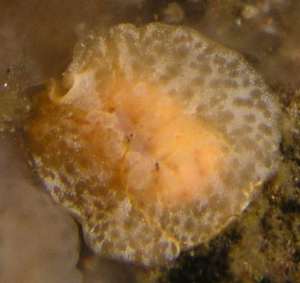
We found what appears to be a Corambe pacifica. However, there were no bryozoans nearby and the coloration seems a little off to be C. pacifica. Any ideas as to what it may be?
Locality: Point Lobos, California, USA. Pacific Ocean. Depth: 70 feet. Length: 15 mm. 04 May 2005. rocky crevice. Photographer: Carmelita Hansen
Thanks.
Douglas Hansen
mhel0323@sbcglobal.net
Hansen, D.S., 2005 (May 16) Corambe? or velutinid from California. [Message in] Sea Slug Forum. Australian Museum, Sydney. Available from http://www.seaslugforum.net/find/13774Dear Doug,
Your animal certainly looks quite like Corambe, but I suspect it is a species of velutinid, which are a family of snails which have their flattened shell embedded in the skin. They therefore look like sea slugs. If my identification is correct, the rounded fold you can see at the top left of the animal, is an anterior siphon which assists a water current into the mantle cavity and gill which are protected by the shell. Have a look at the Fact Sheet and other messages to get an idea of the variety in this family
Best wishes,
Bill Rudman
Velutinid from Lord Howe Island
February 26, 2004
From: Ian Hutton
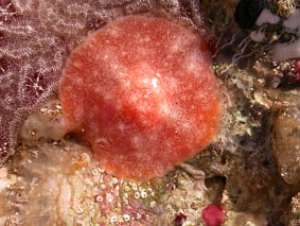
Hi Bill
Wandering along the Middle Beach rock platform observing under loose rocks I found this unknown to me sea slug - about the size of a 20 cent piece, and definitely a sea slug, as when turned over it had a small creeping foot. [Lord Howe Island, Tasman Sea]
Ian Hutton
lhitours@bigpond.com
Hutton, I., 2004 (Feb 26) Velutinid from Lord Howe Island. [Message in] Sea Slug Forum. Australian Museum, Sydney. Available from http://www.seaslugforum.net/find/12312Dear Ian,
This is a slug-like snail rather than a sea slug. Both can have a creeping foot. This is a velutinid or lamellariid. They are often mistaken for slugs because the shell is usually hidden internally. They are often found on, or near, colonies of ascidians on which they feed. You can see a colony of ascidians in the top left of your photo
Best wishes
Bill Rudman
Berthella? fromNew South Wales
September 18, 2003
From: Rachel Przeslawski
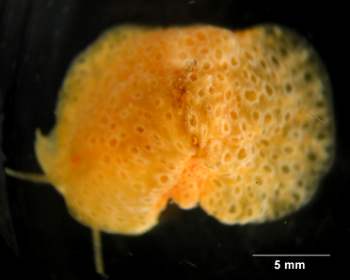
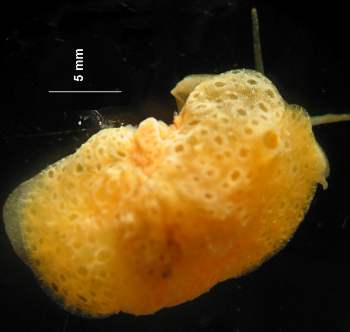
Hi Bill,
I found this Berthella (?) recently, under a rock at an intertidal boulder field in Wollongong, New South Wales [Australia]. It looks remarkably like a sponge, but I didn't see any similar looking sponges around ... maybe it was out for a nice spring crawl. It also had an odd constriction in the centre of it's body. I didn't have much luck using available resources, but can you identify the species?
Thanks!!
Rachel
rachelp@uow.edu.au
Przeslawski, R., 2003 (Sep 18) Berthella? fromNew South Wales. [Message in] Sea Slug Forum. Australian Museum, Sydney. Available from http://www.seaslugforum.net/find/10995Dear Rachel,
Although it looks like a pleurobranch, this is in fact a 'snail' rather than a 'slug'. It is a member of the Velutinidae. The pair of long tapering head tentacles are a good sign that this is not an opisthobranch. The shell is comnpletely enclosed inside the skin, and the 'constriction' you mention is in fact a siphon to channel water into the mantle cavity. These species are often well camouflaged, and although it looks quite sponge-like, it is an better match for its food - an ascidian colony.
Best wishes,
Bill Rudman
Sea slug mystery
March 18, 2003
From: Steve Zanieri
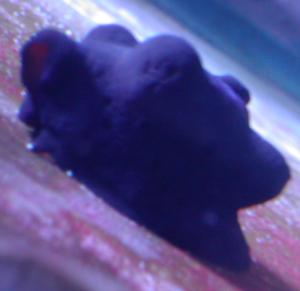
Steve Long suggested I try you for help in the I.d. of this animal. It was purchased from my LFS who didn't have a clue about it. It is black with white tips to the antennae and large lumps on its back, it was described as a Quasimodo Sea Slug, but I cant find any reference to it. Any help on diet and whether suitable to reef tanks would be appreciated.
Thanks,
Steve Zanieri
steven@zanieri.freeserve.co.uk
Zanieri, S., 2003 (Mar 18) Sea slug mystery . [Message in] Sea Slug Forum. Australian Museum, Sydney. Available from http://www.seaslugforum.net/find/9426Dear Steve,
This is a snail that looks like a slug, because its shell is now hidden inside its skin. It belongs to a family called the Velutinidae, and velutinids are often mistaken for nudibranchs. This species is probably Chelynotus semperi, but I am not well enough acquainted with the literature on this group to know whether it is just a colour form of another species, Coriocella nigra. As you will see on the Fact Sheet, species of this family seem to feed on colonial ascidians or sea squirts. We don't know much about the biology of velutinids so I don't know if each species has a particular species of ascidian it prefers, or whether it will eat any ascidian. I am afraid that as with keeping nudibranchs in aquaria, your chances of keeping this animal alive and healthy is fairly slim. Even if you identified its food, getting a colony of its preferred ascidian for your aquarium, and keeping it alive and healthy - while being eaten alive - would not be an easy task.
Cheers,
Bill Rudman
Velutinid from Lord Howe Island
December 11, 2002
From: Ian Hutton
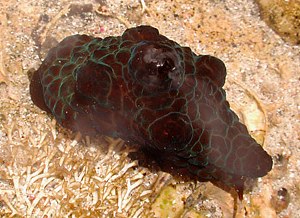
Again, can anyone assist with ID of this slug photographed in intertidal rockpool at Ned's Beach Lord Howe Island. Slug was underneath weed covered rock during day. Size about 4cm long, and about 3.5cm high- the bulges on body quite high. Generally the upper body surface quite rigid.
Ian Hutton
alfa@tpgi.com.au
Hutton, I., 2002 (Dec 11) Velutinid from Lord Howe Island. [Message in] Sea Slug Forum. Australian Museum, Sydney. Available from http://www.seaslugforum.net/find/8597Dear Ian,
This is a snai masquerading as a slug. It is a velutinid, a group of snails with an internal or partly internal shell. As I have said in earlier messages, Chelynotus semperi has been used for this species but I am not well enough acquainted with the literature on this group to know whether it is just a colour form of Coriocella nigra.
Best wishes,
Bill Rudman
Is this a velutinid ?
October 28, 2002
From: Marina Poddubetskaia
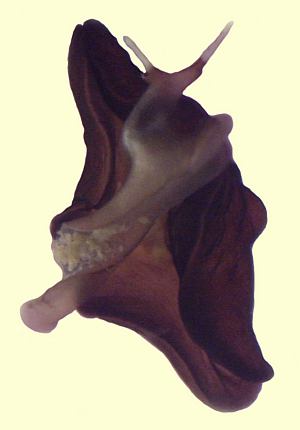
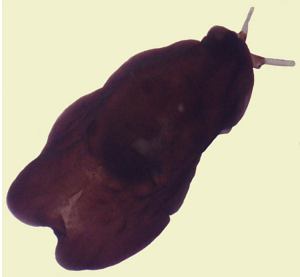
Dear Bill,
I found this tiny guy under a dead coral. Its rhinophores are really strange and I didn't find any gill. So, I think it's a velutinid or something like this. Can you confirm it isn't an opisthobranch, please ?
Date : October 08, 2002
Location : St-Leu, Reunion Island, Indian Ocean
Site : Banc de sable
Depth : 16m
Size : 8-10mm
Photos: Marina Poddubetskaia - Nembro website
Best wishes,
Marina.
nembro@nembro.info
Poddubetskaia, M, 2002 (Oct 28) Is this a velutinid ?. [Message in] Sea Slug Forum. Australian Museum, Sydney. Available from http://www.seaslugforum.net/find/8279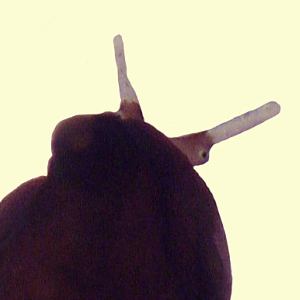
Dear Marina,
Yes this is a velutinid. The little black spot on the broad basal part of the tentacle is its eye. Opisthobranchs never have their eyes on stalks like this, they are always embedded in the skin of the body wall.
Best wishes,
Bill Rudman
Unidentified velutinids from Turkey
October 8, 2002
From: Baki Yokes
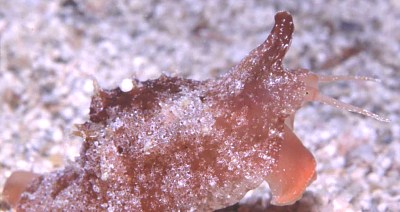
Dear Bill,
I apologize for sending two Velutinids for identification to a seaslug forum. But there is no other place to ask for help :) We have encountered two different species, which I think both are unrecorded lessepsians. Can you help me to identify these.
Upper & Lower Right: Antalya, Turkey, Divesite: Uc Adalar, Depth: 20m, on sand. Size: 5cm, May, 2002. Photo: Adnan Büyük ado2000tr@yahoo.com
Lower Left: Antalya, Turkey, Divesite: Uc Adalar, Depth: 15m, found on seagrass Cymodocea nodosa, but photographed on rocky surface to get a clear picture. Size: 3,5cm. May, 2002. Photo: Baki Yokes
Thank you & best wishes
Baki
bakiyokes@turk.net
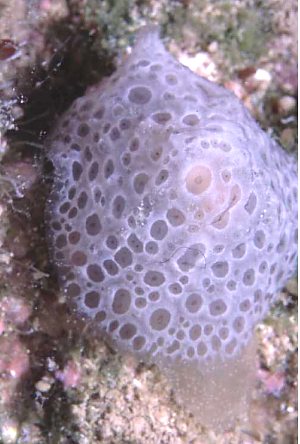
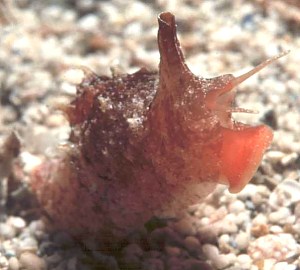
Dear Baki,
One problem with identifying velutinids, is that almost all the taxonomy has been done on shell morphology. In most description the animal has not even been mentioned! So identifying species from live animals or photos of live animals is difficult. I suspect the pinkish brown one is a colour form of Lamellaria perspicua, but I can't give you a name for the whitish one. It reminds of a photo I have seen of a European species but I can't find it at present. Hopefully someone can help you out.
best wishes,
Bill Rudman
Chelynotus semperi from Solomon Ids
September 19, 2002
From: Bruce Potter
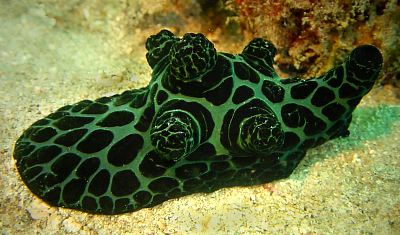
Dear Bill,
The following is not a sea slug, and you may not be interested in it. Please ignore it if you would prefer it not to appear on your site. I found it on Sunday August 13 at about 12 meters on a rubble and coral site near Honiara, Solomon Islands. It was about 90mm long.
What I am wondering is if it is Chelynotus semperi
Regards
Bruce Potter
bruce.potter@adventist.org.sb
Potter, B., 2002 (Sep 19) Chelynotus semperi from Solomon Ids. [Message in] Sea Slug Forum. Australian Museum, Sydney. Available from http://www.seaslugforum.net/find/7778Dear Bruce,
I am happy to include animals like this velutinid, which are often mistaken for nudibranchs. Chelynotus semperi has been used for this species but I am not well enough acquainted with the literature on this group to know whether it is just a colour form of Coriocella nigra.
Cheers,
Bill Rudman
Velutina? from Alaska
September 7, 2002
From: James H. McLean
Dear Bill,
Angel Valdes alerted me to the photo of the "mystery" snail from Alaska. It is definitely Velutina prolongata Carpenter, 1864. What shows of the shell agrees with that. We have preserved specimens showing the checkered mantle edge, which confirms the identification for me, but I have not seen a photo of the living animal. So this is nice to know.
Regards,
Jim
James H. McLean
(Emeritus Curator of Mollusks)
Natural History Museum of Los Angeles County
jmclean@nhm.org
McLean. J.H., 2002 (Sep 7) Velutina? from Alaska. [Message in] Sea Slug Forum. Australian Museum, Sydney. Available from http://www.seaslugforum.net/find/7910Thanks Jim,
It is an interesting addition to our knowledge - even if it isn't a sea slug
Cheers,
Bill Rudman
Snail? Slug? from Alaska
August 7, 2002
From: Clinton Bauder
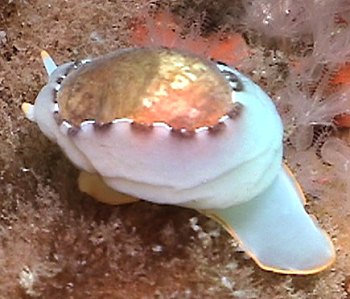
Hi Bill,
So with this one I'm going to display my complete igorance of all things with shells. Not sure if this guy even belongs on your site but one thing's for sure, I don't know what it is! There were lots of them at Coronation Island in Alaska, July 2002. Depth was about 12m. Size was maybe 60-70mm.
Clinton
PS: In late breaking news Jeff Goddard tells me the snail is probably Velutina plicatilis but might be V. prolongata. The original descriptions were based on shells making ID of a live animal from a photo problematic
Clinton
gecko1@apple.com
Bauder, C., 2002 (Aug 7) Snail? Slug? from Alaska. [Message in] Sea Slug Forum. Australian Museum, Sydney. Available from http://www.seaslugforum.net/find/7688NOTE: See Jim McLean's 7 Sept 2002 message identifying this as Velutina prolongata Carpenter, 1864.
Dear Clinton,
I've added your PS to your original message. Before your PS arrived, a number of us here at the museum had been puzzling over your photo. We had wondered about it being a velutinid but basically felt that without an animal we couldn't identify it. Since getting your PS I have tried, without success, to find an illustration of a living Velutina. I didn't realise the shell of species of Velutina was so exposed. The Velutinidae is a family which now includes those snails, with internal shells, which we used to place in the family Lamellariidae (Lamellaria, Coriocella etc) and are often mistaken for nudibranchs. I look forward to any further comments on this animal's identity
Best wishes,
Bill Rudman
Re: Opisthobranch? from Mediterranean
July 23, 2002
From: Juan Lucas Cervera
Dear Bill,
I think Jean-Pierre's animal is Lamellaria perspicua. This species has a high degree of color variation.
Cheers,
Lucas.
lucas.cervera@uca.es
Cervera, J.L., 2002 (Jul 23) Re: Opisthobranch? from Mediterranean. [Message in] Sea Slug Forum. Australian Museum, Sydney. Available from http://www.seaslugforum.net/find/7632Thanks Lucas,
Bill Rudman.
Opisthobranch? from Mediterranean
July 22, 2002
From: Jean-Pierre Bielecki
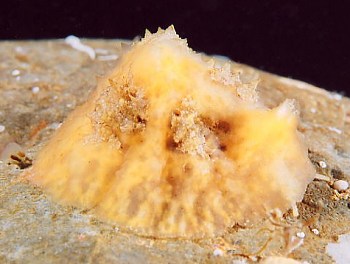
Hi Bill,
Last week we organized with other “bio diving instructors” a Sea slugs course with a scientist who is director of the museum history natural of Le Havre (north of France, www.ville-lehavre.fr/museum/index.htm). We chose the small town of Cerbère, that has a marine nature reserve (in the south of France, on the border with Spain) because the diving center is one of the more dynamic about the studies of the marine life, and for the richness of its Mediterranean fauna and flora. In a week we saw 43 different species. Some were rather rare.
We found this one in 15m depth under a stone that we turned up and its size was 25mm. The problem is we have never seen this species before and we don't know what order it belongs to. We tried to see if it had a shell and a lung, but no luck, and we couldn't find a gill either. We can see only a external siphon that is a fold of the notum. Unfortunately our scientist friend is not a malacologist, but only a sea slug fanatic like us. We preserved the specimen into formol to study possibly later the radula. With these pictures, is there somebody can help us to ID and know more about this species?
Best regards.
Jean-Pierre
bielecki.jeanpierre@free.fr
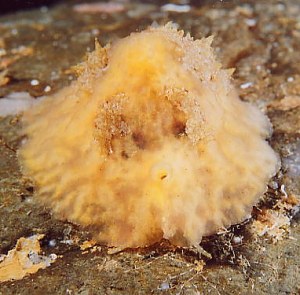
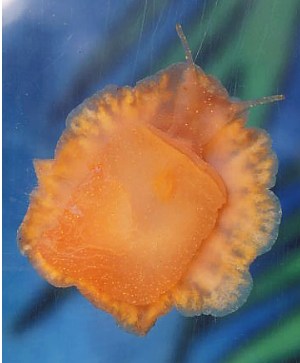
Dear Jean-Pierre,
In the lower right photo, which shows the underside of the animal and its head, you can see that the eyes are on swellings at the base of the head tentacles. The eyes are very faint because they are on the upper side of the head. That is a good sign that this is a 'snail' rather than an opisthobranch. I am pretty sure this is a velutinid or lamellariid. Your mention of an anterior siphon being formed by a fold of the skin also suggests that family. Have a look at the Fact Sheet and other messages on that page for more information on the group. They have quite a large ear-shaped internal shell, a bit like that of Haliotis, but quite colourless. These animals are often mistaken for nudibranchs, and sometimes, like flatworms, I have to give them a second look in the field before deciding what they are. Best wishes,
Bill Rudman
Opisthobranch with a shell
September 19, 2001
From: Elianny Dominguez
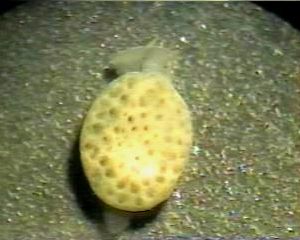
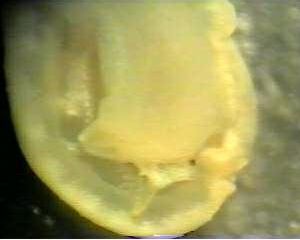
Dear Bill,
I saw some animals of the genera Berthellina or Berthella in the Forum and I noticed that they have a soft shell on top of them. I wonder if this animal belongs to that same genera. As you can see it also has a soft shell which is pink with dark brown spots on the mantle. On one of the pictures you can see the head (below the shell) with two small black eyes.
We found the animal under a rock (Colombia, Santa Marta, Caribbean), at about 10 cm of depth; and it has 2.5 cm of length.
Cheers,
Elianny Dominguez.
elicelotte@latinmail.com
Dominguez, E. , 2001 (Sep 19) Opisthobranch with a shell. [Message in] Sea Slug Forum. Australian Museum, Sydney. Available from http://www.seaslugforum.net/find/5278Dear Elianny,
There may be a fragile shell beneath the skin, but the soft tissue is in fact the mantle rather than a soft shell. Thi animal is not an opisthobranch and is most probably a snail of the family Velutinidae (=Lamellariidae) or perhaps the Triviidae. Some marine snails have reduced, flattened internal shells, covered by a layer of mantle. I think yoru animal is one of those.
Best wishes,
Bill Rudman
Coriocella spp from the Maldives.
May 8, 2001
From: Jim Anderson
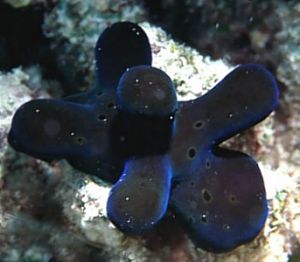
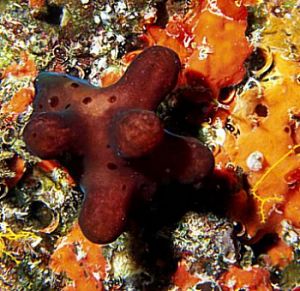
Dear Dr. Rudman,
Attached are a couple of images from the Maldives.
The 'blue' one is I think Coriocella nigra and was identified by my German buddy as a 'blue-sponge-snail', but in German of course. These animals have been a common feature of all my visits to the Maldives and have been observed crawling about the reef in daylight hours generally at or around 14 - 24 metres, which happens to be my 'favourite' range while nudi hunting there.
The 'brown' specimen was photographed on a night dive in Mar 1997 on a beautiful wall at 14 m. It was approx 55 mm across.
Regards
Jim Anderson
jander4454@aol.com
Anderson, J., 2001 (May 8) Coriocella spp from the Maldives.. [Message in] Sea Slug Forum. Australian Museum, Sydney. Available from http://www.seaslugforum.net/find/4219Thanks Jim,
If I followed my own rules I wouldn't include these on the Forum but they are interesting aren't they? I wouldn't mind betting that these two are the same species. Unfortunately there is still a lot of work to be done on these animals. For those of you unfamiliar with these animals have a look at the top of the page where these slug-like snails are described.
It must be a bit of a shock to go back the Scotland after the Maldives. Your upgraded Scottish Nudibranch website at http://www.a4454.freeserve.co.uk/scotnud1.html is looking good.
Best wishes,
Bill Rudman
Mystery from the Maldives
January 16, 2001
From: Nishina Masayoshi


Dear Bill,
Can you help me with this animal which I cannot identify from the Maldives.
Nishina Masayoshi
nishina@hpe15.wips.co.jp
Masayoshi, N., 2001 (Jan 16) Mystery from the Maldives. [Message in] Sea Slug Forum. Australian Museum, Sydney. Available from http://www.seaslugforum.net/find/3521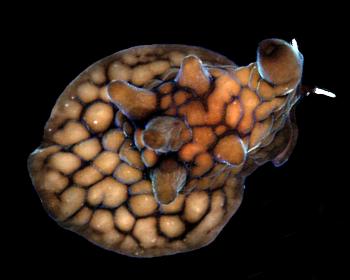
Dear Nishina,
This is a snail with a hidden shell. It belongs to the Family Velutinidae which includes a group we previously considered a separate family, the Lamellariidae. I suspect it is Coriocella nigra but I am not an expert on these animals. They are very difficult to see clearly in photos because they are so black. I include alongside a photo I took of a juvenile at Lifou (November 2000). It is a bit overexposed to show its shape. Note the white head tentacles on the upper right. The eyes are on a swollen basal part of the tentacles. Have a look at the other messages on this page to see some of the variety of colour and shape in this family of slug-like snails.
Best wishes,
Bill Rudman.
Velutinid from Port Stephens
May 28, 2000
From: Ron Greer
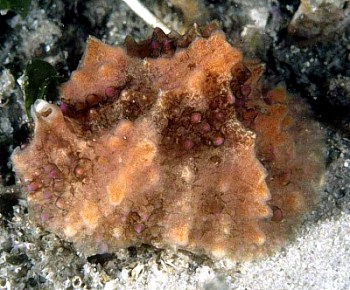
Dear Bill,
Late last year I sent you a couple of images for ID that you confirmed as Petalifera ramosa. That week of diving was the most prolific I had seen in 10 years at Fly Point [Port Stephens, New South Wales, Australia]. Of the 25+ species I saw were 5 that I have been unable to ID. Here is one of them. I hope you can ID for me.
Regards,
Ron
diveimage@i-o.net.au
Greer, R., 2000 (May 28) Velutinid from Port Stephens. [Message in] Sea Slug Forum. Australian Museum, Sydney. Available from http://www.seaslugforum.net/find/2463Dear Ron,
Although it has no sign of a shell, the single siphon or tube, which you can see at the left of your picture, suggest that this is a velutinid, which are a family of marine snails with flattened internal shells.
Best wishes,
Bill Rudman.
Velutinid from southern New South Wales
January 27, 2000
From: Akos Lumnitzer
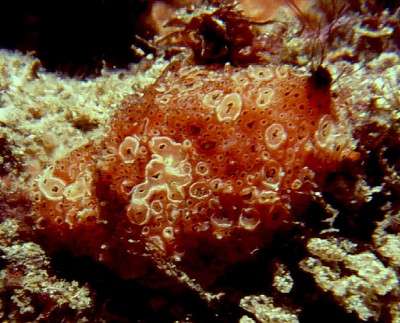
Dear Dr.Rudman
is this species a Trippa intecta?
Best wishes
Akos Lumnitzer
Aglphoto@aol.com
Lumnitzer, A., 2000 (Jan 27) Velutinid from southern New South Wales. [Message in] Sea Slug Forum. Australian Museum, Sydney. Available from http://www.seaslugforum.net/find/1799Dear Akos,
No this is Mystaconcha wilsoni which is illustrated on the bottom left of the Velutinid Page. The velutinids [previously Lamellariidae] are a group of snails in which the flattened shell ahs been covered over by the mantle so they look like sea slugs. Many species are very well camouflaged on the ascidian colonies on which they feed.
Best wishes,
Bill Rudman.
Re: Coriocella nigra from Japan
October 6, 1999
From: H.Ono
Dear Bill,
Thank you for your answer.
Your Sea Slug Forum is very exciting!
H.Ono
hal9001@green.ocn.ne.jp
Ono, H., 1999 (Oct 6) Re: Coriocella nigra from Japan. [Message in] Sea Slug Forum. Australian Museum, Sydney. Available from http://www.seaslugforum.net/find/1402Coriocella nigra from Japan
October 5, 1999
From: H. Ono
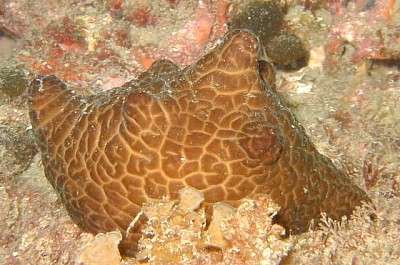
Hello,
What is this animal? Is this a sea slug or a kind of snail? I found it several times throughout the year except in winter.
Data: Oct 2nd 1999, depth 15m, on rock. water temp 25 degree. length 60mm. Tateyama southern point(about 180km southsoutheast of Tokyo)of Boso peninsula, Chiba pref, Japan.
Thanks lot to share your time for me.
H. Ono.
hal9001@green.ocn.ne.jp
Ono, H., 1999 (Oct 5) Coriocella nigra from Japan. [Message in] Sea Slug Forum. Australian Museum, Sydney. Available from http://www.seaslugforum.net/find/1400Dear Mr Ono,
This is a snail, not a Sea Slug. Have a look at the Top of this Page for some information on the velutinid snails, in which the shell is usually hidden within the skin. This animal is probably Coriocella nigra Blainville, 1824. It can grow to 10cm and is found throughout the tropical Indo-West Pacific.
Best wishes,
Bill Rudman.
Coriocella nigra
May 5, 1999
From: Jacquie Sheils
I work as a tour guide at Hardy Reef, on the Great Barrier Reef, about 80km NE of the Whitsunday Islands.
For several years we have regularly observed specimens of Coriocella nigra on the reef we visit. I wish I there was more information available on their biology! Having found out that they feed on ascidians I'll take more notice of where I see them in future. I seem to see them more frequently in the cooler months of the year, rarely in the summer, could this have something to do with food availability or life cycle?
What I'd really like to know is, what are the knobs on their backs for?!
Jacquie Sheils.
jsheils@mackay.net.au
Sheils, J., 1999 (May 5) Coriocella nigra. [Message in] Sea Slug Forum. Australian Museum, Sydney. Available from http://www.seaslugforum.net/find/826Dear Jacquie,
I bet there are a lot of people who would like your job! As you will see from the Lamellariid or rather, as they should be called, the Velutinid page, these animals are not really 'Sea Slugs'. Though as I made the rules I guess I can stretch them a bit. You are right about the lack of information on these animals. What would be great would be somebody like you who is on the spot to 'adopt' a species and keep regular records of when they are around, what size they are, what they appear to be eating, and any other interesting natural history observations. Photos are a good way to record such information if you have access to a camera. It is possible that they are around all year but only big enough to be noticed in the winter. Until you know what they actually eat, and many animals only feed on one or a very few prey species, it is not possible to say whether food availability restricts their numbers.
Concerning the large tubercles on their backs. To me they look like a soft coral that has retracted its polyps so one guess I would make is that the tubercles are a form of camouflage, but I might be quite wrong.
Best wishes,
Bill Rudman.
A nudibranch-like Coriocella from Okinawa
March 23, 1999
From: Bob Bolland

Hi Bill:
I thought you might like to see a scan of one of the bizarre opisthobranch-like prosobranchs which are occasionally found on Okinawa. The enclosed scan is of Coriocella sp. which was collected from Horseshoe Cliffs from 55m during a daytime dive. The animal was collected from beneath a slab of coral rubble on 11 September, 1994. The crawling length of the animal was 68mm. Several others, apparently of the same species, have also been collected during night dives, but these were found in the upper 3m at the reef edge. Do you have this same animal in your part of the world?
In addition, I've collected a dozen or so other opisthobranch-like prosobranchs (Lamellaria spp.), which are very colonial sponge-like/colonial tunicate-like, and seem to be quite diverse in both color and form.
Cheers, Bob
OKINAWA
bolland@imicom.or.jp
Bolland, R.F., 1999 (Mar 23) A nudibranch-like Coriocella from Okinawa. [Message in] Sea Slug Forum. Australian Museum, Sydney. Available from http://www.seaslugforum.net/find/714Thanks Bob,
I am afraid the velutinids (= lamellariids) have not been well-studied in Australia, but they are certainly here. I have already posted pictures of a few above. Unfortunately they have all been described on shell features. Until someone compares the living animals with their shells, taxonomic confusion will reign supreme. Sounds a bit like the Haminoea story.
There are preserved specimens in museum collections but they are not much more use than the empty shell, unless they are accompanied by information on the colour and the shape of the living animal.
They would be a fascinating group to study their natural history. Why are some very cryptic, while others flaunt their strange shapes and colours? Clearly there will be parallels with the opisthobranchs who have also had to find ways of protection which don't include a shell.
Bill Rudman.
Your response to my Coriocella query
November 2, 1998
From: Yves Muller
Dear Bill,
Thank you for your answer.
Your Sea Slug Forum is very interesting.
Yves
ymuller@netinfo.fr
Muller, Y., 1998 (Nov 2) Your response to my Coriocella query. [Message in] Sea Slug Forum. Australian Museum, Sydney. Available from http://www.seaslugforum.net/find/286Yves, If you have photos or observations on sea slugs you would like to share, they would be very welcome. .. Bill Rudman
Information on Coriocella spp
October 28, 1998
From: Yves Muller
Dear Bill,
During a dive in the Ari atoll (Maldives), I have observed the mollusca genus Coriocella, probably species hibyae pictured page 58 in the "seaslug and seasnail of H. Debelius. But I can't found information about this genus and species Coriocella and its biology. This genus belong naturally in family Lamellariidae. Have you some more information or references on Coriocella. Thank you.
Yves Muller
ymuller@netinfo.fr
Muller, Y., 1998 (Oct 28) Information on Coriocella spp. [Message in] Sea Slug Forum. Australian Museum, Sydney. Available from http://www.seaslugforum.net/find/283Dear Yves,
Your question was passed to me from the Museum's search & discover centre. Although Coriocella is not a sea slug these animals are often mistaken for slugs so it is good to have something about them in the Sea Slug Forum.
Have a look at the top of the page of some general information. Firstly the family name is now considered to be Velutinidae instead of Lamellariidae. Sorry about that. Unfortunately there is very little known about the biology of these animals othr than most seem to feed on compound ascidians (tunicates). Their shell is usually buried in the fleshy mantle wall and so they have adopted some nudibranch defensive mechanisms such as colour camouflage, in some cases, and bright (probably warning) colours, in other cases.
Most species have been named from the dead shells, which are often very similar in shape. Until someone undertakes some detailed research on the Family we are going to continue to have identification problems. There are lots of good photographs of living animals but no attempt has been made as yet to match the living animals with the dead shells.
I hope this is of some value. If you have photos or questions on sea slugs please send them .... Bill Rudman.
Rudman, W.B., 1998 (Oct 28). Comment on Information on Coriocella spp by Yves Muller. [Message in] Sea Slug Forum. Australian Museum, Sydney. Available from http://www.seaslugforum.net/find/283